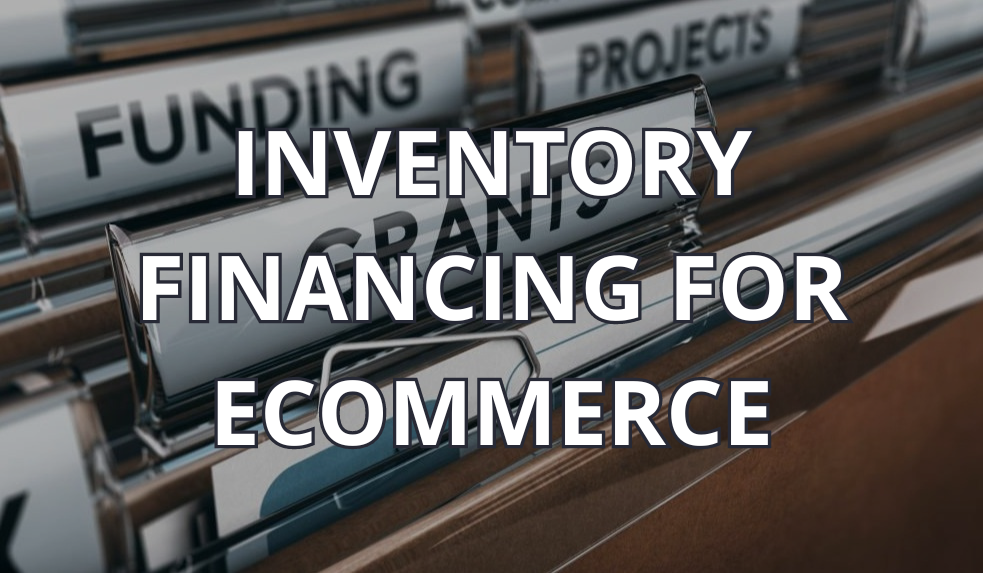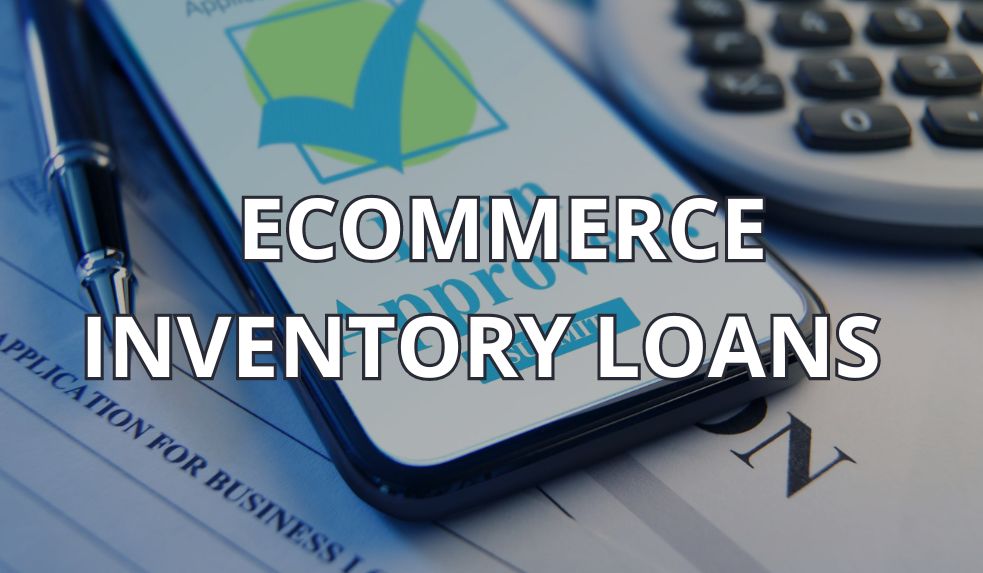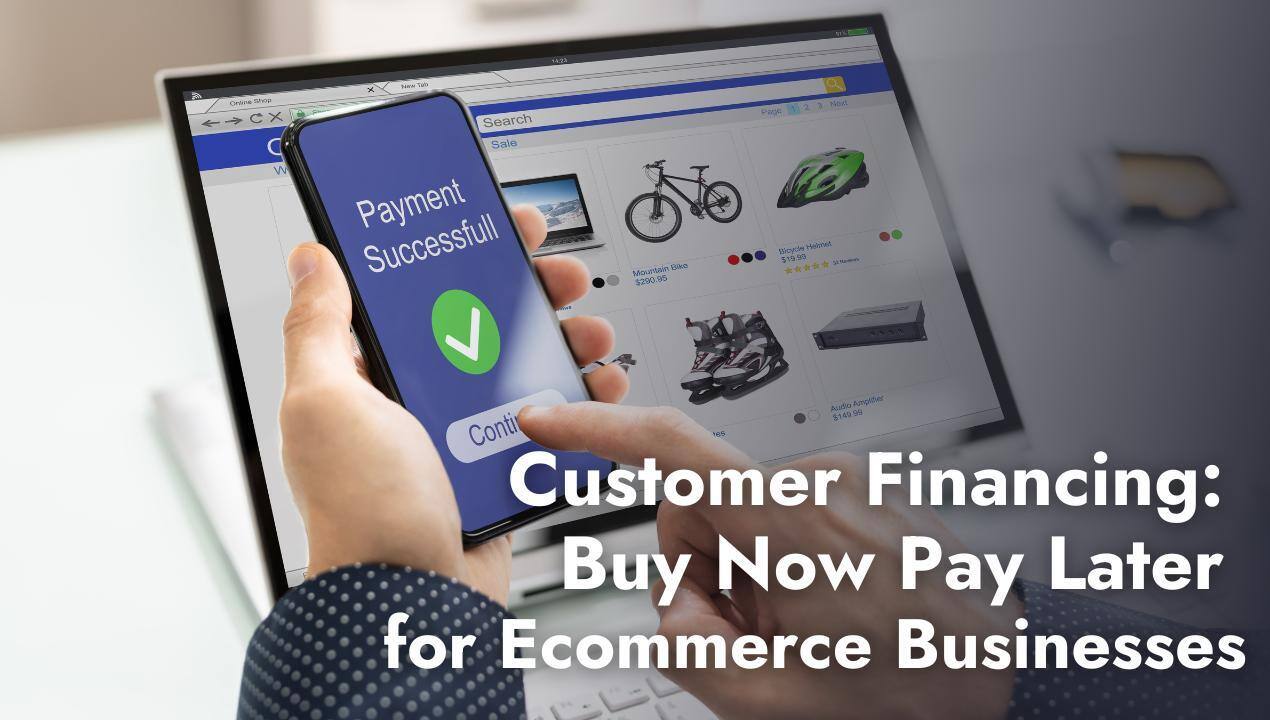Share this
Guide to Alternative Inventory Funding Options for Ecommerce
by Kyla Friel on Jan. 31, 2024

It’s a necessity to have the right amount of inventory on hand when running an ecommerce business. That amount can change depending on circumstances, like seasonal peaks or launching a new product, and it's common for ecommerce businesses to secure financing to fund that additional inventory. It’s also common for ecommerce businesses to choose an alternative inventory funding option over traditional loans.
But what alternative inventory funding streams exist for a business that doesn’t want to go the inventory loan route? Thankfully, there are many different financing types that you can choose from, depending on your circumstances and business funding needs. These include non-debt-based options like equity financing and debt-based options like revenue-based lending.
This article will guide you through the pros and cons of the most popular alternative inventory funding options for ecommerce businesses to help you choose the best type of financing to secure.
Non-Debt-Based Inventory Funding Options
Running an ecommerce business is expensive, and many business owners don’t want to take on more debt than they need to. Several types of inventory funding options don’t involve taking on debt but can still help you secure the financing you need. A few of the most popular options are below, with pros, cons, and details of how these various types of inventory financing work.
Equity Financing
Equity financing is a method of raising capital for a business by selling shares in the company. Unlike debt financing, where you borrow money and must pay it back with interest, equity financing involves selling a portion of your business's ownership in exchange for funding.
The shares sold represent parts of the ownership of the company. Investors who buy these shares become part owners of the business to the extent of the shares they hold. Equity financing can provide significant amounts of capital, potentially more than what might be available through traditional inventory financing loans, especially for businesses with a solid growth plan.
Deciding whether equity financing is right for your ecommerce business depends on several factors, including your growth stage, the amount of capital needed, your willingness to share control, and your business model's scalability.
For example, early-stage companies with high growth potential that are not yet profitable may find equity financing suitable. This is because they might not have the cash flow to support debt repayments.
Companies with highly scalable business models are often more attractive to equity investors since they promise higher returns on investment. If your ecommerce business has the potential to grow rapidly without proportionately increasing its operating costs, equity financing might be a viable option.
Pros of Equity Financing
No Debt Obligations: There’s no need to repay the capital or pay interest, which can benefit startups or businesses with limited cash flow in the growth phase.
Access to More Capital: It can provide significant amounts of capital, potentially more than what might be available through inventory loans, especially for businesses with a solid growth plan.
Expertise and Networking: Investors may offer strategic guidance, mentorship, and access to a broader network, which can be invaluable for navigating the competitive ecommerce landscape.
Cons of Equity Financing
Loss of ownership and control: When you sell ownership shares to investors, they become shareholders and gain influence in the company's decision-making processes. Depending on the extent of their ownership, they may have a say in how the business is run, potentially leading to conflicts over the direction of the company.
Dilution of profits and decision-making power: As your ecommerce business distributes profits to shareholders, including investors, your ownership stake may entitle you to a smaller portion of those profits. Additionally, decisions about the company's future direction may require consensus among shareholders, leading to slower decision-making and potential disagreements.
Complexity and Time-Consuming: Finding the right investors, negotiating terms, and complying with legal requirements can be complex and time-consuming.
Crowdfunding
Crowdfunding is a method of raising capital through the collective effort of friends, family, customers, and individual investors. This approach taps into the collective efforts of a large pool of individuals—primarily online via social media and crowdfunding platforms—and leverages their networks for greater reach and exposure.
Ecommerce businesses create crowdfunding campaigns on platforms like Kickstarter, Indiegogo, and GoFundMe. Supporters often contribute money to the campaign in exchange for early access to products or other rewards. Businesses can use the collected funds for inventory purchases.
To start your campaign, determine the amount of money you need to raise for your inventory funding needs and set a clear goal. Develop a compelling campaign that outlines your business idea, goals, and the rewards for backers. This typically includes a video, a detailed project description, and attractive reward tiers.
Share your campaign widely through social media, email newsletters, and other marketing channels to attract backers. Once your campaign is funded, deliver on the promises made to backers, such as product pre-orders, experiences, or acknowledgments.
Pros of Crowdfunding
Market Validation: Crowdfunding can serve as a way to validate your product or business concept before fully launching it. High interest and backing indicate market demand.
Builds Community: It helps in building a community of supporters who are invested in your business's success.
No Debt or Equity Sacrifice: Unlike loans or equity financing, crowdfunding does not require you to pay back the money or give up a share of your business. If you don't reach your funding goal, you usually don't owe anything to the backers.
Publicity and Exposure: Successful campaigns can generate significant publicity, helping to market your product and brand.
Cons of Crowdfunding
Intense Competition: Crowdfunding platforms can be highly competitive, with numerous projects vying for the attention of potential backers. Your ecommerce campaign must stand out and effectively communicate its value proposition to succeed. This can require significant marketing efforts to rise above the competition, which can occupy a lot of time.
Public Disclosure: You need to share your business idea publicly, which could be a risk if you're concerned about competition.
Fixed Goals: Some platforms operate on an all-or-nothing basis, where you must reach your goal to receive any funds.
May not be suitable for larger funding needs: While crowdfunding can be effective for raising relatively modest sums of money, it may not be suitable for larger funding needs, such as substantial inventory purchases or significant business expansion. Crowdfunding campaigns are often most successful when focusing on specific projects, products, or creative endeavors.
Grant Programs
Grant programs provide non-repayable funds to ecommerce businesses for specific purposes, such as inventory financing, research and development, or expansion. Government agencies, foundations, or private organizations typically award grants.
Ecommerce businesses must apply for grants through a competitive process. If approved, they receive funds to support their inventory needs without the obligation of repayment. Grants often come with specific eligibility criteria and project requirements.
To start, identify grant programs that fit your ecommerce business well. Focus on those specifically targeting businesses of your size, startups, ecommerce platforms, or your particular industry. Applications typically require detailed business plans, financial statements, a description of how you will use the funds, and how the grant will support your business goals.
Some popular grants for ecommerce businesses include the FedEx Small Business Grant and the Amber Grant for Women. There are also various government grants your business may qualify for.
Pros of Grant Programs
Non-repayable Funds: The most significant advantage of grant programs is that they provide non-repayable funds to ecommerce businesses. This can significantly reduce the financial burden on your business and allow you to allocate funds directly to inventory purchases or other growth initiatives.
No Equity Required: Grants do not involve giving up ownership shares or incurring debt obligations. This means that your ecommerce business retains full ownership and control, and no financial liability is associated with the grant funds.
Credibility and Recognition: Receiving a grant can enhance your business's credibility and can be used in marketing efforts.
Cons of Grant Programs
Limited Availability and Competition: Grants are highly competitive, and not all ecommerce businesses may qualify or receive approval. The availability of grants can be limited, and you may face stiff competition from other businesses seeking the same funding. As a result, securing a grant can be challenging and uncertain.
Specific Use of Funds Restrictions: Grant programs often have specific eligibility criteria, project goals, and restrictions. This means that if you receive a grant, you may need to use the funds for a particular purpose or adhere to specific guidelines set by the grant provider. Meeting these requirements can sometimes limit your flexibility in using the funds.
Complex Application Process: The application process can be lengthy and complex, requiring detailed business plans and financial statements.
Vendor Financing
Vendor financing, also known as trade credit or supplier credit, is a form of financing in which a vendor extends credit to a business, allowing the business to buy products or inventory without immediate payment. The repayment terms are agreed upon by both parties and typically include a set period (e.g., 30, 60, 90 days) after delivery of goods, within which the payment must be made.
Vendor financing can provide the necessary flexibility if your business experiences seasonal sales fluctuations or you’re looking to free up cash for other investments. Vendor financing is also best suited for short-term financing needs rather than long-term investments or capital improvements.
To take advantage of vendor financing, you must first negotiate terms with your suppliers. You'll discuss the amount of credit they're willing to extend, the repayment period, and any interest or fees associated. Once terms are agreed upon, you can purchase inventory from the vendor under these terms, receiving the goods immediately but deferring payment according to the agreed timeline.
Pros of Vendor Financing
Improves Cash Flow: By deferring payment for inventory, your business can maintain more cash on hand for other operational expenses.
Builds Business Relationships: Establishing a vendor financing arrangement can strengthen your relationship with suppliers, potentially leading to more favorable terms or priority treatment in the future.
Simplifies Approval Process: Vendor financing can be easier to obtain than traditional loans, especially for businesses with a good track record with their suppliers.
Flexibility: Terms can sometimes be negotiated to fit your business's needs, offering more flexibility than traditional financing options.
Cons of Vendor Financing
Limited by Supplier Willingness: Vendor financing is contingent on having specific relationships with suppliers willing to extend credit or offer favorable terms. Not all suppliers may provide such financing arrangements, limiting your options and potentially tying you to specific vendors.
May Not Cover All Inventory Needs: While vendor financing can assist with certain inventory purchases, it may not cover all of your inventory needs. Some suppliers may have limitations on the amount or types of inventory they are willing to finance. This could necessitate additional financing sources for specific inventory requirements.
If you're interested in learning more about all of the inventory funding options for ecommerce businesses, including traditional loan options, you can download our free guide below.
Download our Inventory Financing Guide
Debt-Based Inventory Funding Options
Not all debt is bad; in many instances, it can be a strategic tool for business growth and sustainability. For ecommerce businesses looking to scale or manage their inventory more effectively, various debt-based funding options offer structured and potentially cost-effective ways to finance these needs. Below, we explore some of the widely utilized debt-based inventory funding options and their pros and cons.
Revenue-Based Lending
Revenue-based lending allows businesses to receive upfront capital in exchange for a portion of their future revenue until the loan, plus a fee or interest, is repaid. It's a flexible financing solution that adapts to the business's sales, making it an attractive option for businesses with fluctuating revenue, like many ecommerce operations.
This type of funding is particularly suited to businesses with strong sales but perhaps not enough collateral or credit history that more conventional loans require.
To access this inventory funding stream, your business must apply for funding with a lender who specializes in revenue-based financing. The lender assesses the business's financial health, including revenue streams and growth prospects.
The business repays the loan through a fixed percentage of its monthly revenue. The total amount to be repaid includes the borrowed amount plus a predetermined fee or interest. The repayment amount adjusts with the business's revenue, increasing in high-revenue months and decreasing when revenues fall.
Some popular revenue-based lenders include Clearco, Kickfurther, and Wayflyer.
Pros of Revenue-Based Lending
Repayment Flexibility: Revenue-based lending repayments are directly linked to your ecommerce business's daily or monthly revenue. This flexible repayment structure can help ease financial strain during slower periods and ensure that repayments align with your cash flow.
Easier Qualification: Revenue-based lending typically has more lenient qualification requirements than traditional bank loans. This makes it more accessible for businesses with limited credit history or those that may not meet the stringent criteria of traditional lenders. As a result, it can be a viable option for startups and small businesses.
No Dilution of Equity: Unlike equity financing, revenue-based lending doesn't require business owners to give up any ownership stake.
Cons of Revenue-Based Lending
Higher Overall Cost: One of the main drawbacks of revenue-based lending is the higher overall cost of borrowing. Lenders receive a percentage of your daily or monthly revenue, which can add up to a significant expense over time. This makes revenue-based lending more expensive than traditional loans with fixed interest rates.
Potential Revenue Constraints: Since repayments are directly tied to your revenue, there's a risk this may limit your ability to reinvest in the business. During periods of high sales, a significant portion of your revenue may go toward loan repayments, affecting your ability to grow or manage other financial obligations.
Asset-Based Lending
Asset-based lending is a type of financing where a business secures a loan by using its assets as collateral. This can include inventory, accounts receivable, equipment, and other property owned by the business. Ecommerce businesses often use their inventory as collateral, making asset-based lending a viable option for funding.
The lender evaluates the assets you wish to use as collateral, determining their current market value. Based on the appraisal, the lender offers a loan amount, usually a percentage of the asset's value. They will also set terms, including interest rates and repayment schedules.
Pros of Asset-Based Lending
Flexibility: Loan amounts are based on asset values, potentially providing more capital than unsecured loans, especially if the business has significant inventory.
Less Emphasis on Credit History: Because the loan is secured by assets, lenders may be less concerned with the business's credit history than unsecured loans.
Cons of Asset-Based Lending
Risk of Losing Assets: The primary drawback of asset-based lending is that if your ecommerce business fails to meet its repayment obligations and defaults on the loan, the lender has the legal right to take possession of the collateral. Losing your inventory or other assets can be a significant risk.
Complex Asset Valuation: Asset-based lending involves thoroughly evaluating the collateral's value and due diligence processes. This can be a complex and time-consuming procedure, requiring detailed documentation and appraisals. It may also involve ongoing monitoring of the collateral's value throughout the loan term.
Business Credit Cards
Business credit cards are specialized credit cards issued to businesses rather than individuals. They are designed to help businesses manage expenses, including operational costs, supplies, and inventory purchases. These cards often come with features tailored to business needs, such as higher credit limits, rewards programs (e.g., cashback, points, travel benefits), and year-end summaries to help simplify business expense tracking.
To be approved for a business credit card, your business must apply for a credit card with a bank or financial institution. Approval and credit limits are based on the business's credit history and financial health.
Like personal credit cards, businesses must make at least the minimum payment on the card balance each billing cycle, though paying the balance in full avoids interest charges.
Some of the most popular credit cards for ecommerce businesses include the Chase Ink Business Preferred card, the American Express Business Gold card, and the Capital One Spark Business card.
Pros of Business Credit Cards
Ease of Use: Credit cards are widely accepted and can be used immediately upon approval.
Flexibility: They provide a flexible line of credit for managing cash flow, allowing businesses to purchase inventory as needed.
Rewards and Incentives: Rewards programs can offer significant value back to the business on purchases it would make anyway.
Build Credit: Responsible use can help build a business's credit profile, making it easier to secure other forms of financing in the future.
Cons of Business Credit Cards
Interest and Fees: High interest rates and potential fees can make credit cards an expensive form of financing, especially if balances are carried over monthly.
Credit Limit Constraints: Credit limits may not be sufficient for all your inventory financing needs, especially for larger purchases.
Impact on Credit: High utilization rates or late payments can negatively impact your business credit score.
Merchant Cash Advances (MCAs)
With merchant cash advances (MCAs), businesses receive a lump sum of cash upfront, which is repaid through a percentage of their daily credit card sales, plus a fee. Unlike traditional loans with fixed monthly payments, the repayment amount for an MCA adjusts with your daily sales volume, making it a flexible option tied directly to your business's revenue performance.
Merchant cash advances might seem similar to revenue-based lending. But where revenue-based lending considers all revenue streams, MCAs are based on credit card sales and can be a more expensive loan option.
MCA providers will specify what is known as a holdback amount to be deducted from future transactions. This amount is determined as a percentage. For instance, with a 15% holdback, the lender would deduct 15 cents from every dollar of the borrower's credit and debit card transactions. The borrower commits to gradually repaying the advance through their daily or weekly credit and debit card sales until the entire amount is settled.
To get approved for a merchant cash advance, the MCA provider will review your business's credit card sales history to determine eligibility and the advance amount. Repayment usually starts immediately, and MCAs are typically used for short-term financing needs.
Pros of Merchant Cash Advances
Quick Access to Capital: MCAs are known for their quick turnaround times. To obtain an MCA, businesses typically only need basic financial documentation, such as bank and credit card processing statements. This can be beneficial if your business requires immediate capital to seize opportunities or address urgent inventory needs.
Flexible Repayments: Payments are based on a percentage of daily sales, adjusting with your business's revenue. This can be beneficial during slower sales periods.
No Collateral Required: MCAs don't require collateral, which can be a relief for businesses without assets they’re willing to secure a loan against.
Less Stringent Qualification Criteria: MCAs often have more lenient eligibility requirements than traditional bank loans, focusing more on sales history than credit scores.
Cons of Merchant Cash Advances
High fees: MCAs come with fees that are typically calculated as a factor of the total amount advanced to your business. These fees can be substantial, often expressed as a percentage of the advance. For example, if you receive a $10,000 MCA with a factor rate of 1.5, you would owe a total of $15,000 ($10,000 x 1.5). These fees are considered high compared to most traditional business loans.
Effective APR (Annual Percentage Rate): While MCAs don't have traditional interest rates like loans, they do have an effective APR. The effective APR measures the total cost of borrowing, including fees, over a year. It's used to help borrowers compare the cost of MCAs to other financing options. The effective APR for MCAs can be exceptionally high, reflecting the substantial cost of the fees associated with MCAs.
Potential cash flow issues if sales decline: While MCAs offer flexibility by adjusting repayments to your daily sales, there's still a minimum daily repayment amount that you must meet. If your sales decrease significantly, this fixed repayment obligation can become burdensome, putting pressure on your cash flow.
Inventory Management With a Top-Rated 3PL
Securing the right funding option is the next step in growing your ecommerce business. Having ample financing to fund additional inventory and product launches is a key factor in being able to scale, appeal to a larger market, and keep up with your ecommerce order demand.
However, ecommerce inventory management can be difficult on its own – not to mention when trying to market your products and run your business at the same time! That’s why many growing businesses partner with a top-rated 3PL provider like Shipfusion.
Partnering with Shipfusion for your order fulfillment means accessing our proprietary inventory management software. You’ll be able to effortlessly sync your inventory data across all sales channels in real-time, whether that be through an integration with Shopify, Amazon, TikTok Shop, or any other ecommerce platform your business uses.
All inventory is tracked from when it enters our warehouse to when it ships out to your end customer, meaning you can focus on scaling your business instead of ensuring your inventory is accurate. And with Shipfusion’s turnkey fulfillment solutions and white-glove onboarding, you can immediately start fulfilling your orders with 99.9% accuracy. If you’re ready to focus less on inventory management and more on business growth activities, contact one of our fulfillment experts today.
Share this
You May Also Like
These Related Articles

Complete Ecommerce Inventory Financing Guide For 2024

Guide to Inventory Loans for Ecommerce

Customer Financing: Offer Buy Now Pay Later as an Ecommerce Business
- April 2025 (9)
- March 2025 (26)
- February 2025 (26)
- January 2025 (37)
- December 2024 (16)
- November 2024 (23)
- October 2024 (22)
- September 2024 (27)
- August 2024 (9)
- July 2024 (8)
- June 2024 (5)
- May 2024 (8)
- April 2024 (8)
- March 2024 (6)
- February 2024 (6)
- January 2024 (5)
- December 2023 (3)
- November 2023 (3)
- October 2023 (5)
- September 2023 (4)
- August 2023 (2)
- July 2023 (1)
- June 2023 (4)
- March 2023 (2)
- October 2022 (1)
- September 2022 (5)
- August 2022 (4)
- July 2022 (7)
- June 2022 (4)
- May 2022 (4)
- April 2022 (6)
- March 2022 (2)
- February 2022 (1)
- January 2022 (3)
- December 2021 (2)
- November 2021 (4)
- October 2021 (2)
- September 2021 (5)
- August 2021 (4)
- July 2021 (4)
- June 2021 (3)
- May 2021 (2)
- April 2021 (3)
- March 2021 (3)
- February 2021 (3)
- January 2021 (2)
- December 2020 (4)
- November 2020 (2)
- October 2020 (4)
- September 2020 (2)
- July 2020 (5)
- June 2020 (4)
- May 2020 (2)
- April 2020 (2)
- March 2020 (4)
- February 2020 (1)
- December 2019 (1)
- May 2018 (1)
- March 2018 (2)
- February 2018 (3)
- January 2018 (3)
- November 2017 (3)
- July 2017 (4)
- March 2017 (3)
- February 2017 (5)
- January 2017 (3)
- December 2016 (4)
- November 2016 (6)
- October 2016 (6)
- October 2015 (1)
- September 2015 (1)
- June 2015 (3)
- May 2015 (3)
- August 2014 (1)
- July 2014 (1)
- March 2014 (1)
- February 2014 (1)